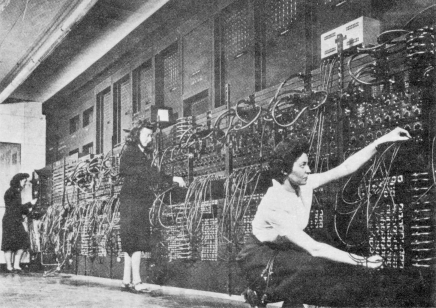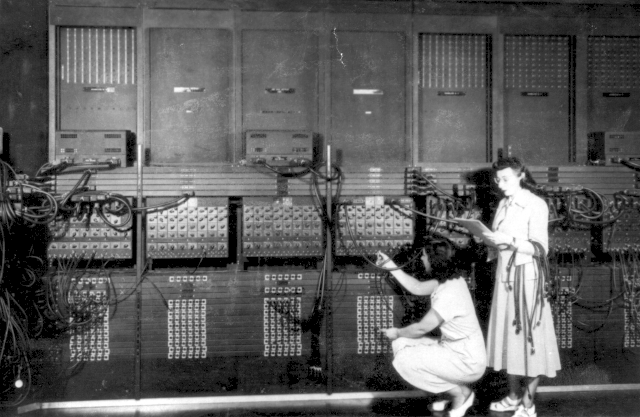Adele Goldstine (1920-1964)
In the 1940s, Adele Goldstine was one of a team of women who programmed the ENIAC, the world's first electronic computer. (In case you don't remember your computer history, this thing was a giant, folks--it took up an entire room and could do fewer algorithms than a modern pocket scientific calculator.) Goldstine also wrote the ENIAC's technical manual. Here's a little snippet:
"The basic electronic memory device of the ENIAC is the flip-flop. A flip-flop consists essentially of a pair of triodes so connected that at any given time only one of the pair can be conducting. When a certain one of the tubes is conducting (and the other is not), the flip-flop is said to be in the normal state; when the other tube is conducting (and the first is not), the flip-flop is in the abnormal state."
So, from what I gather, she wrote about abnormal flip-flops--something that sounds like it would give you bad blisters. (Okay, please forgive me--I am obviously joking to cover up my gross ignorance on the subject!)
Goldstine and her colleagues were called "computers," a job which entailed plugging and unplugging cables into the ENIAC so as to program it to crunch numbers. I'm not sure why this team was all women, but considering the lack of women in science and technology fields at the time, it is quite significant. Is it because the job appeared to an ignorant observer to be a simple telephone switchboard, a piece of technology women of the time were allowed to operate? I love the pictures of these gals in their 1940s work costumes, busily rewiring this electronic juggernaut:

[image from: http://www.hp9825.com/html/stan_frankel.html ]

[image from: http://ftp.arl.army.mil/ftp/historic-computers/gif/eniac4.gif ]
Here's a snapshot of them all in a car (Why in the trunk of a car? I do not know. Is that where they were stowed until it was time to get some serious work done?):

[image from: http://www.indwes.edu/Faculty/bcupp/lookback/hist-10.htm ]
Apparently, most, if not all of them, eventually married one of the male operators of ENIAC. Goldstine herself came onto the project as the wife of the lead administrator of the ENIAC's construction. Unfortunately, her husband's accounts of her input on the project were dismissive. I find it amazing that people could make any progress during this era of hideous racism and sexism. It is a testament to how smart and industrious Goldstine must have been to emerge from such oppression and disrespect and still make her mark on the history of technology.
1 comment:
What a great post! I think you're right - the guys probably had the women do all the actual computing because it looked like a switchboard, and was therefore both feminine and "uncool." Now they are kicking themselves in their graves, because they realize - "Dangit, we should have been there! Why did we let them do the awesome stuff?" Meanwhile, the women are like, "Yeah, we knew it all along, we just didn't want to tell you."
Post a Comment